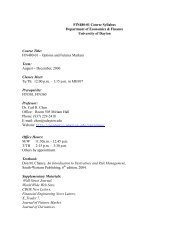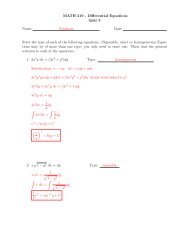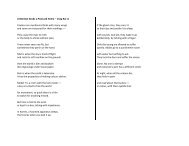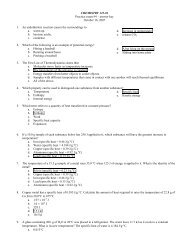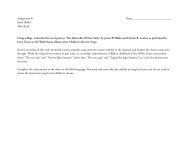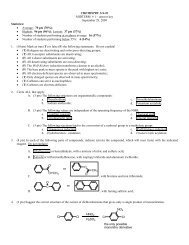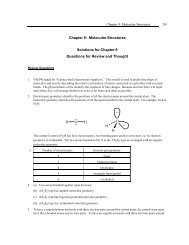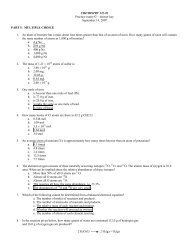Chap 26
Chap 26
Chap 26
Create successful ePaper yourself
Turn your PDF publications into a flip-book with our unique Google optimized e-Paper software.
228 CHAPTER 10<br />
text and will suggest checkable deposits. Almost always you will obtain some not-so-excellent<br />
answers, ranging from gold to shares of stock to credit cards.<br />
The point of this exercise is to obtain these incorrect answers because they give you a chance to<br />
discuss why these items are not money. Without ridiculing the wrong answers, you might point out<br />
that students rarely pay for books by giving the bookstore shares of IBM stock and asking for change<br />
in AT&T stock. By being involved and having to think, the students emerge with a stronger grasp of<br />
why money is measured as it is.<br />
Fiat money. To get across the idea of money, take a green piece of paper and cut it to the same size as<br />
a dollar bill. Then take the paper into class along with a dollar bill. Ask the students why one piece of<br />
paper has value and the other does not. Is there anything intrinsically more valuable about the dollar<br />
bill? If not, why won’t someone in class exchange his or her old wrinkled piece of green paper with<br />
writing on it for the nice new piece you offer?<br />
The contrast between money in economics and money in everyday language. It can be helpful to<br />
emphasize that “money” is a technical term in economics that has a precise meaning and that differs<br />
from its looser usages in every day language. For example, an economist would not say “Bill Gates<br />
makes a lot of money.” Rather, the economist would say “Bill Gates earns a large income.” An<br />
interesting exercise is to have students think of statements containing the word “money” that make<br />
complete sense in normal language but that misuse the word in its precise economic sense, and to<br />
get them to explain why.<br />
A picky point. The textbook is careful to not use the term money supply in this chapter. Instead, it<br />
talks about the quantity of money. The money supply appears in the next chapter and is reserved for<br />
the relationship between the quantity of money and the interest rate, other things remaining the<br />
same. It parallels the demand for money. Although this point might seem picky, you can help your<br />
students by using this same language convention.<br />
2. Depository Institutions<br />
What do banks do? Students usually have bank accounts, but often they have never fully thought<br />
through what banks do, how they do it, or what the differences are between banks and other deposittaking<br />
institutions, so what tends to strike instructors as rather dry descriptive material can be<br />
interesting to students. It is worth being explicit about the fact, which students tend to be very aware<br />
of, that in practice commercial banks earn income not only by the spread between their deposit and<br />
lending rates, but also by charging fees for their services. The text focuses on the role of depository<br />
institutions as a source of credit creation; for most students, like most customers, their most<br />
important function is actually facilitating the payment process, and a little discussion on that (and<br />
how relatively cheap it is) can also engage students.<br />
Financial Regulation, Deregulation, and Innovation. This topic can be easily motivated with a few<br />
‘horror stories’—either of the 1930s or of the Savings and Loan scandals of the 1980s. Deposit<br />
insurance is a great example of an idea that created unintended consequences because of how it<br />
changed incentives for bankers; the Savings and Loan debacle illustrates the problem very well.<br />
A good discussion can arise out of asking students for suggestions as to how the negative<br />
consequences of current deposit insurance could be avoided while maintaining the benefits—bright<br />
students may see the possibilities in risk-adjusting premiums for banks or privatizing the insurance<br />
mechanisms. Students often think of innovation as inherently involving new concrete things—<br />
machines or products. Financial innovation is a great context in which to get over the idea that nonmaterial<br />
innovations can be at least as important economically—perhaps the idea of limited liability<br />
being the archetype of a financial innovation with enormous economic impact.




